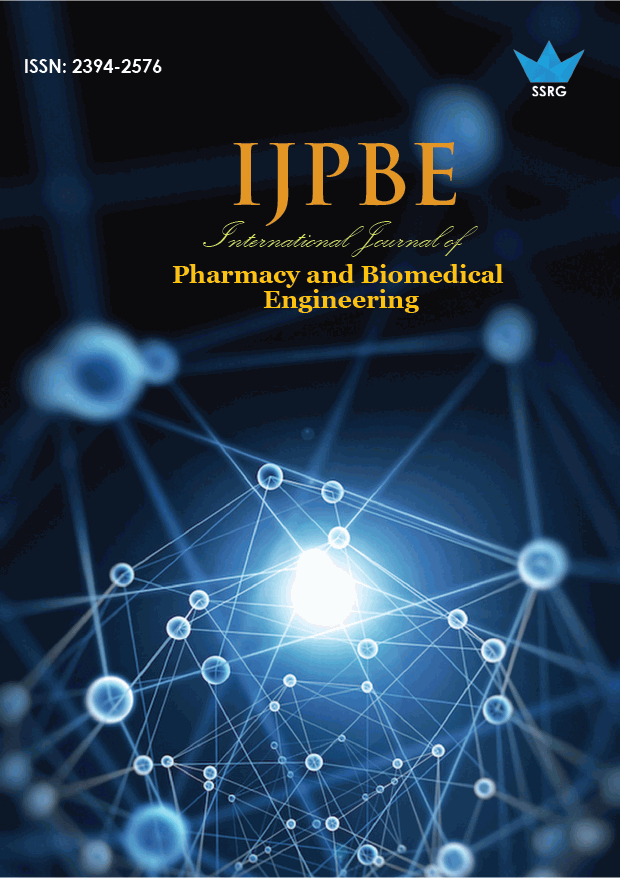Beneficial Medicine Observing in Psychotherapy: A Significant Step in Medical Practice

| International Journal of Pharmacy and Biomedical Engineering |
| © 2017 by SSRG - IJPBE Journal |
| Volume 4 Issue 2 |
| Year of Publication : 2017 |
| Authors : P.O.Alastair and E.B.Culbert |
How to Cite?
P.O.Alastair and E.B.Culbert, "Beneficial Medicine Observing in Psychotherapy: A Significant Step in Medical Practice," SSRG International Journal of Pharmacy and Biomedical Engineering, vol. 4, no. 2, pp. 1-4, 2017. Crossref, https://doi.org/10.14445/23942576/IJPBE-V4I2P101
Abstract:
TDM in psychotherapy is an instrument to optimize the beneficial regimens in medical practice. Psychopharmacology encompasses those drugs which metabolize, and their metabolites also are active in the body. CYP-450 of antipsychotics is unique as the drugs are lipid-soluble, and the assorted class of drugs act on dissimilar types of receptors and produce changeable responses. A variety of techniques are concerned to approximate the drug levels of those drugs. HPLC is a golden typical to assay the serum drug attentiveness of these drugs. The metabolites can also be assayed along with the parent drug. TDM of these drugs, if applied at a tertiary care, individualization of the amount regime of these drugs can help the outcomes of analysis, and even drug-drug communication can exhibit the PK/PD nature of such drugs.
Keywords:
TDM, PK/PD, ICD, DSM-IV, CYP, PM, CYP3A4, CYP2C19
References:
[1] Peck CC, Barr WH, Benet LZ, Collins J, Desjardins RE, Furst DE, Harter JG, Levy G, Ludden T, Rodman JH, et al. (1994). Opportunities for integration of pharmacokinetics.
[2] APA (2000). Diagnostic and statistical manual of mental disorders DSM‐IV‐TR. American Psychiatric Association of Washington, DC.
[3] WHO (2000). “Global Burden of Disease (GBD) 2000 estimates”. World Health Organization.
[4] Cameron OG (1999). Psychopharmacology. Psychosom Med 61(5): 585‐590.
[5] Scordo MG & Spina E (2002). “Cytochrome P450 polymorphisms and response to antipsychotic therapy”. Pharmacogenomics 3(2): 201‐218.
[6] Hardman J, Limbird L, Molinoff P, Ruddon R & Goodman Gilman A (1996). “Goodman & Gilmans The pharmacological basis of therapeutics”, 9th edition. U.S.: McGraw‐Hill Companies, Inc.
[7] Tucker GT (2000). Chiral switches. Lancet 355(9209): 1085‐ 1087.
[8] Xie HG, Kim RB, Wood AJ & Stein CM (2001). “Molecular basis of ethnic differences in drug disposition and response”. Annu Rev Pharmacol Toxicol 41: 815‐850.
[9] Spina E, Scordo MG & DʹArrigo C (2003). “Metabolic drug interactions with new psychotropic agents”. Fundam Clin Pharmacol 17(5): 517‐538.
[10] Eichelbaum M & Evert B (1996). “Influence of pharmacogenetics on drug disposition and response”. Clin Exp Pharmacol Physiol 23(10‐11): 983‐985.
[11] Bertilsson L, Dahl ML & Tybring G (1997). “Pharmacogenetics of antidepressants: clinical aspects”. Acta Psychiatr Scand Suppl 391: 14‐21.
[12] Uges DR & Schootstra R (1987). “Changed pharmacokinetics under the influence of age.” Pharm Weekbl Sci 9(2): 50‐5.
[13] Lundmark J, Reis M & Bengtsson F (2000). “Therapeutic drug monitoring of sertraline: variability factors as displayed in a clinical setting”. Ther Drug Monit 22(4): 446‐454.
[14] Poole Arcangelo V & Peterson AM (2006). “Pharmacotherapeutics for advanced practice:” a practical approach, 2nd edition. Philadelphia: Lippincott Williams & Wilkins.
[15] Ratanasavanh D, Beaune P, Morel F, Flinois JP, Guengerich FP & Guillouzo A (1991). “Intralobular distribution and quantitation of cytochrome P‐450 enzymes in the human liver as a function of age”. Hepatology 13(6): 1142‐1151.
[16] Beierle I, Meibohm B & Derendorf H (1999). “Gender differences in pharmacokinetics and pharmacodynamics”. Int J Clin Pharmacol Ther 37(11): 529‐547.
[17] Horsmans Y, Desager JP & Harvengt C (1992). “Absence of CYP3A genetic polymorphism assessed by urinary excretion of 6 beta‐hydroxy cortisol in 102 healthy subjects on rifampicin”. Pharmacol Toxicol 71(4): 258-261.
[18] Kroon, LA (2007). “Drug interactions with smoking”. Am J Health Syst Pharm 64(18): 1917-1921.
[19] Carrillo JA & Benitez J (2000). “Clinically significant pharmacokinetic interactions between dietary caffeine and medications”. Clin Pharmacokinet 39(2): 127-153.
[20] Compher, CW (2004). “The impact of protein-calorie malnutrition on drugs. Handbook of Drug-Nutrient Interactions”: edited by Joseph I. Boullata and Vincent T. Armenti.
[21] Back DJ & Orme ML (1990). “Pharmacokinetic drug interactions with oral contraceptives”. Clin Pharmacokinet 18(6): 472 - 484.
[22] Goldstein LH, Elias M, Ron Avraham G, Biniaurishvili BZ, Madjar M, Kamargash I, Braunstein R, Berkovitch M & Golik A (2007). “Consumption of herbal remedies and dietary supplements amongst patients hospitalized in medical wards”. Br J Clin Pharmacol 64(3): 373-380.
[23] Zhou S, Chan E, Pan SQ, Huang M & Lee EJ (2004). “Pharmacokinetic interactions of drugs with St Johnʹs wort”. J Psychopharmacol 18(2): 262-276.
[24] Bjerrum L, Sogaard J, Hallas J & Kragstrup J (1998). “Polypharmacy: correlations with sex, age, and drug regimen”. A prescription database study. Eur J Clin Pharmacol 54(3): 197- 202.
[25] LeSage J (1991). “Polypharmacy in geriatric patients”. Nurs Clin North Am 26(2): 273‐90.

 10.14445/23942576/IJPBE-V4I2P101
10.14445/23942576/IJPBE-V4I2P101